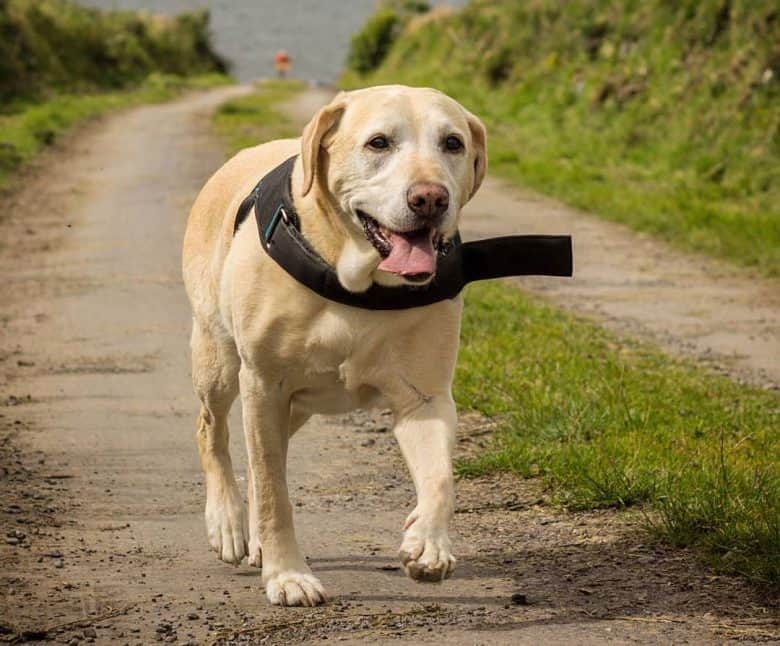
Labrador Retrievers have become one of the top dog breeds around the globe. The breed is known for its friendly nature, intelligence, and loyalty. Understanding their body language is a difficult task for most pet owners. Understanding your dog’s body language is crucial for building strong bonds and effective communication.
What body language can I read in my Labrador?
Labradors communicate non-verbally, and their body language can be used to tell us if they are happy, sad, angry or fearful, or confident. Your Labrador cannot express himself verbally so he prefers to communicate through body language.
Canine body language is the combination of facial expressions, body postures, and other body movements that can communicate a dog’s emotions and intentions.
It’s our responsibility to understand this language so that we can better communicate with them.
This article will explain the different body language signs that your Labrador can display. We’ll also discuss what these signals mean and how you should respond. Understanding your Labrador’s body language will help you to strengthen the bond between your dog and yourself. He will feel loved, respected, and understood. Let’s learn how to read your Labradors’ body language.
Understanding Labrador Retriever Body Language

It is important to understand body language
Dogs communicate nonverbally through body language. Understanding your Labrador’s body-language is important for communicating and forming a bond with him.
Canine body language is composed of facial expressions, body postures, and intentions. We must learn to understand this body language.
Canine body language: Components
The canine body language includes the following: tail, eye, leg, facial expressions and posture.
A tail that is wagging indicates happiness, excitement or nervousness. On the other hand, a tail that has been tucked in can show fear or submission.
The Labrador Retrievers’ almond-shaped eyes are expressive, and they can show emotions like happiness, fear or anxiety. A dog’s position can also indicate the state of mind. For example, relaxed shoulders indicate calmness, while a playful bow indicates playfulness.
Recognizing Labrador Retriever Body Language
Understanding your Labrador’s body language and emotions is essential to understanding their intentions.
A relaxed, open mouth may indicate that a dog is happy, relaxed, or even content, whereas a growl, or snarl, can be indicative of an angry or frustrated dog.
If a Labrador Retriever is showing whale eyes, where their whites are clearly visible, this can be interpreted as anxiety or fear. A dog who’s yawning, or licking its lips, may also feel nervous or uncertain.
You should also pay close attention to the tone and pitch of the barking, as well as the speed and direction at which the tail is wagging.
Fast, fast-wagging tails indicate excitement, happiness or joy, while slow, stiff wags may be an indication of insecurity, fear or anxiety. High-pitched barking is a sign of excitement while low-pitched grunts are a sign of fear and aggression.
Labrador retriever body language is also a good indicator of submissiveness and dominance. Dogs that are looking away from you or avoid eye contact could be submissive, or even scared. While if they stare directly at your face it may indicate that the dog is feeling confident or dominant.
A dog with a raised hairline on its spine or shoulders can be displaying fear.
Any dog owner will find it useful to understand Labrador Retriever’s body language. You can protect and reassure your dog by recognizing and interpreting the nonverbal signals of your canine companion.
Common Labrador Retriever Body Language

You can communicate more effectively with your Labrador retriever by understanding its body language.
Labradors have a friendly, outgoing personality. However, they also show a variety of emotions in their body language. This section will explain some Labrador Retrievers’ body language.
Happy Labrador Retriever Body Language
A Labrador retriever will show a variety of cues in their body language when they are happy.
Labradors do not differ from other dogs that exhibit a tail wag. The Labrador may hold up their ear forward and their and eyebright and alert. The Labrador is likely to make eye contact with their owner, while their body language will also be relaxed.
Fearful Labrador Retriever Body Language
Labrador retrievers can show fear in their body language when they are faced with certain situations.
The Labrador can hide or try to cower, with their tail hidden between their legs. Also, they may avoid eye-contact and hold their ears up. If a Labrador is stressed or afraid, they may yawn or lick frequently.
Aggressive Labrador Retriever Body Language
While labradors tend to be friendly in general, they may become aggressive under certain circumstances. Body language can show aggression, such as a stiff body, raised hackles and a tight tail.
When a Labrador feels attacked or protected, they may growl and show teeth. Understanding the reason for the aggressive behavior is important. If necessary, seek out professional assistance.
Submissive Labrador Retriever Body Language
Submissive Labradors will show body language that indicates they do not pose a threat.
The dog may also lower its head, and tuck their tail between their legs. Submitting dogs can show their teeth by displaying them in a submissive manner.
A submissive labrador does not mean that they are afraid or anxious, but rather trying to convey their non-threatening intent.
Interpreting Labrador Retriever Body Language
| Body Language Cues | Happy Labrador | Fearful Labrador | Aggressive Labrador | Submissive Labrador |
|---|---|---|---|---|
| Tail | Wagging | The legs are tucked in | Tense, stiff | The legs are tucked in |
| Ears | Forward and up | Back to the Homepage | Raised or normal | Cheaper |
| Eyes | Bright and Alert | Eye contact is avoided | Focused or intense | Relaxed |
| Eye contact | Makes eye contact | Avoids eye contact | Variable | Variable |
| Body Posture | Loose and relaxed | Hide or cower | Tense and stiff | Cheaper |
| Yelling | Able | Frequent | Variable | Variable |
| Lip Licker | Able | Frequent | Variable | Variable |
| Glinning | Fear is not a good sign | Fear is not a good sign | Fear is not a good sign | Can indicate submission |
| Display of Teeth | Not aggressive | Not aggressive | Can show teeth | Not aggressive |
| Growing | Not aggressive | Not aggressive | Can growl | Not aggressive |
| Hair on the Back (Hawks) | Relaxed | Relaxed | Raised | Relaxed |
Please note that every Labrador Retriever will have a slightly different variation in body language. To accurately understand their feelings and intentions, it is important to look at their behavior in context.
It is best to seek advice from a dog trainer if you have any concerns about the behavior of your labrador.
The conclusion of the article is:

It is important to understand your dog’s body language in order to communicate with him better. You can understand your Labrador’s needs and emotions by recognizing their signs and signals.
Canine communication can be complex and Labradors do not differ. The signals they use to express their feelings include body postures, facial expressions, and vocalizations. You can determine if your pet is anxious, happy, confused, or angry by paying attention to the cues.
A relaxed posture, an erect tail, and a mouth open are all signs of happiness in a dog. A dog that is anxious or afraid may show a tightened body posture with a tucked-in tail and growl. A wagging dog’s tail is not always a sign that the animal is happy. It can be an indication of fear or nervousness.
Dogs that are confident or anxious may show different body language, like standing up or crouching. When your dog becomes angry or fearful, you should protect and reassure them.
Understanding your Labrador’s body language will help you to build a strong bond and maintain their health and happiness. You can improve your relationship with your dog by observing its behavior, and then responding in a considerate and safe manner.